

JJ (Jeannette James) sur Twitter : "The importance of vision #leadupchat #principall @Principal_Lead @aitsl #aussieED #ozpln #vicpln @EduTweetOz. Duff Douglas sur Twitter : "Managing Complex Change - food for thought - #uwctech #pd... Five Ways To Create a Healthy School Climate. When children feel cared for by the adults in their school, it creates a sense of belonging and trust.

Collaborative and caring interactions boost self-esteem. In turn, self-esteem boosts academic achievement and decreases problem behavior like bullying. Here are five ways to create a healthy school climate: Create a school-wide plan. Get everybody on board. TeachThought sur Twitter : "25 Critical Thinking Strategies For The Modern Learner. 25 Critical Thinking Strategies For The Modern Learner. Critical thinking is the engine of learning.
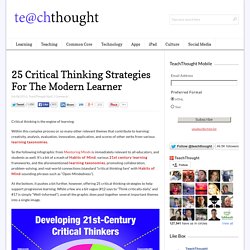
Within this complex process or so many other relevant themes that contribute to learning: creativity, analysis, evaluation, innovation, application, and scores of other verbs from various learning taxonomies. So the following infographic from Mentoring Minds is immediately relevant to all educators, and students as well. It’s a bit of a mash of Habits of Mind, various 21st century learning frameworks, and the aforementioned learning taxonomies, promoting collaboration, problem-solving, and real-world connections (standard “critical thinking fare” with Habits of Mind-sounding phrases such as “Open-Mindedness”). At the bottom, it pushes a bit further, however, offering 25 critical thinking strategies to help support progressive learning. Certification sur Twitter : "@MikeAndriulli: "The Most Important Lesson" Via @RosaIsiah #WeLeadEd #principALL. Learn.share.grow.: The Most Important Lesson.
Yesterday, I was doing a puzzle with my two-year-old daughter, which has become one of my favorite activities to do with her.
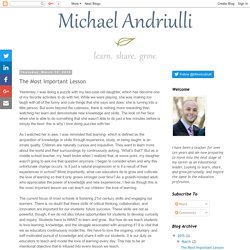
While we were playing, she was making me laugh with all of the funny and cute things that she says and does; she is turning into a little person. But even beyond the cuteness, there is nothing more rewarding than watching her learn and demonstrate new knowledge and skills. The look on her face when she is able to do something that she wasn't able to do just a few minutes before is simply the best- this is why I love doing puzzles with her.As I watched her in awe, I was reminded that learning- which is defined as the acquisition of knowledge or skills through experience, study, or being taught- is an innate quality. Children are naturally curious and inquisitive. They want to learn more about the world and their surroundings by continuously asking, “What’s that?” Some days it will be a struggle. Signs-of-a-Learning-Culture?mktcops=c.human-capital&mktcois=c.culture-management~c.managing-learning-programs~c.organizational-dynamics~c.integrated-talent-management~c.eval-learning-impact~c.coaching&mkttag=c.
Certification sur Twitter : ""learning is developing the organization, day after day, within the culture" - @MichaelFullan1 #principALL. Twitter. Twitter. Useful Books for Principals and Teachers Infographic. Teacher Infographics Useful Books for Principals and Teachers Infographic As educators work to maintain New Year’s resolutions, this resource will provide them with the support they need to improve their practice and promote academic success for their students.
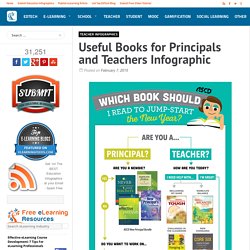
The Useful Books for Principals and Teachers Infographichelps educators determine which professional development publication meets their specific goals. Intended for teachers and principals, the infographic outlines the common challenges facing today’s educators and provides book recommendations as solutions. some of the goals listed in the infographic are achieving work/life balance, improving grading, motivating teachers, and improving school culture. Image uploaded by @Principal_Lead. Www.entrepreneur. Lindsey Lipsky M.Ed. sur Twitter : "Characteristics if a Great Leader. #SatChat... PurposefulPrincipals sur Twitter : "A6- More perspectives are better than 1 perspective #ASCDL2L...
Chris Munro sur Twitter : "Do you work in a franchise or a team? @stevebarkley #educoach #satchatoc #aussieED #principALL... Twitter. Dennita Miskimen sur Twitter : "LEADERSHIP IS... #principALL #edchat #paradigmshift #schoolculture #schoolleaders #edleadership #teacherleadership. A Principal's Reflections: Opinions Are Nice, B... 4 Tips For Leading & Learning As A Busy Principal. 4 Tips For Leading & Learning As A Busy Principal by William Sterrett The role of the principal seems to continually grow, and despite working with people all day, school leaders can feel isolated.
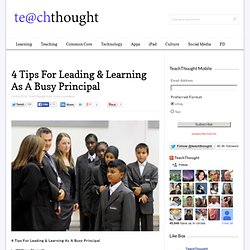
In fact, after becoming principals, educators can stagnate if they are not seeking to lead and learn. Making time to connect with the school’s most important resource—people—is key. Exploring Growth Mindsets #principals. Colleague Jananne Healey and a team of folks created the following presentation for sharing at District Leadership team meeting: It's based on Carol Dweck's book, Mindsets.
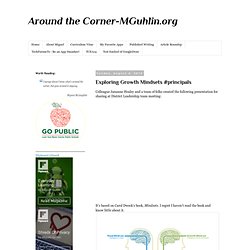
I regret I haven't read the book and know little about it. Fortunately, there's Wikipedia: The premise of Mindset: The New Psychology of Success is the idea that people exercise either a growth mindset or a fixed mindset. Those with a fixed mindset believe their talents and abilities cannot be improved through any means. 6 Ways Principals Can Support Instructional Coaching. [I am honored to offer my readers this guest post by Jim Knight.
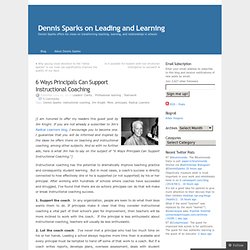
If you are not already a subscriber to Jim's Radical Learners blog, I encourage you to become one. I guarantee that you will be informed and inspired by the ideas he offers there on teaching and instructional coaching, among other subjects. And so with no further ado, here is what Jim has to say on the subject of "6 Ways Principals Can Support Instructional Coaching. "] Instructional coaching has the potential to dramatically improve teaching practice and consequently student learning. Why We Need Principals. There are questions that resonate, holding our imaginations and keeping us wondering.

There are questions that activate our learning, causing us to reflect and helping us to grow. Do We Need Principals? School principals and the rhetoric of ‘instructional leadership’ Today in the education world principals are supposed to be, above just about everything else, “instructional leaders.”
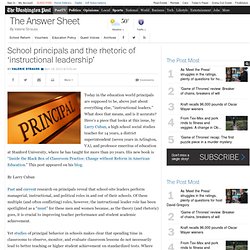
What does that means, and is it accurate? Here’s a piece that looks at this issue, by Larry Cuban, a high school social studies teacher for 14 years, a district superintendent (seven years in Arlington, VA), and professor emeritus of education at Stanford University, where he has taught for more than 20 years. School Climate: Missing Link in Principal Training? 4 Principles for Fostering and Maintaining Authentic 21st Century Leadership. In his book entitled The Mindful Leader: Awakening Your Natural Management Skills Through Mindfulness Meditation, Michael Carroll writes, "When we lead a career that is sharply focused on being more successful, more admired, or just more comfortable, we can deceive ourselves into neglecting the world around us.

We end up managing our lives like projects rather than actually living them. " To add to Carroll's points about authenticity, Dennis Sparks writes, "Outside-the-box leaders know that their authenticity is a potent source of influence and that honesty is at the heart of authenticity. " How then, does a 21st century leader develop this "authenticity"? My Principal Doesn’t Need to Blog. My principal doesn’t blog. This flies in the face of what some consider to be a 21st Century principal and what others have eloquently proposed as a must for principals. The reality is that he doesn’t <gasp> need to blog! Becoming 21st century elementary principals. It seems as though being a principal has really changed. I don’t have much experience in the role compared with others — I have been an elementary principal for six years. However, day by day, it seems to be evolving into something different, which is good, because principals lead buildings that have a reputation for being caught up in the past.
For too long, school has been seen as an institution that does not change. Why Blog? As I reflect on my continuous evolution as an educational leader I am constantly amazed at how things have changed over the course of three years. It was in March of 2009 that I decided to give this social networking tool Twitter a try. At the time I was skeptical about whether my time was going to be well spent posting updates in 140 characters and whether or not people would actually care or be interested in what I was doing. Obviously my perception of Twitter early on was completely wrong as it has radically molded me into the leader and educator that I am today.
1 by Michele Rosen on Prezi. The Power of the Principal - Finding Common Ground. School Should Reflect Real Life. A Prezi Guide to an Effective School - Learning together. Reflective School This week I'm presenting at the "Teaching and Learning Conference" in Amphitheater SD (Tucson AZ). Next week, I will keynote at the "Rigor, Relevance and Relationships Leadership Conference" in Cyprus-Fairbank ISD (Houston TX).
It is Time For Schools to Seriously Consider BYOT. This piece is cross-posted at the Huffington Post.As we continue to move even further into the 21st Century, technology becomes more embedded in all aspects of society. As a father, I see this firsthand with my son, who is in first grade. The gift he wanted the most this past Christmas was an iPod Touch, which Santa was kind enough to bring him. Then there is his younger sister who will regularly ask to use my iPad so she can either care for her virtual horse or dress Barbies in creative ways. As I download all of the apps on these devices, the majority of their time is spent engaged in games that require thought, creativity, and sometimes collaboration.
A blog documenting my learning, as an educator, a leader in education, a mother, and an amateur photographer. Questions about curriculum. Letter to an imaginary educator… Dear Anon, As an educational leader, do you think your decisions should be based on beliefs about how learning best takes place? Here are my school’s articulated learning principles: We learn in different ways, depending on abilities, learning styles, preferences and interests. Learning takes place through inquiry: questioning, exploring, experimenting and problem solving. The Principal of Change. Creativity Fuels Innovation. Thoughts from the Office. Feeding My ED-diction. Lyn Hilt: The Principal's Posts. Shared Learning of Forest Green/CFL. Lead4Learning. Project-Based Learning & iPads at St. Stephen's.
Read the short article that appears in St. Stephen's Today, a publication of St. Stephen's Episcopal Day School in Coconut Grove, Florida. The school is focusing on project-based learning and provides an iPad 2 for each of their students in grades one through five. You can access the original article here. Preparing Our Students for Their Futureby The Technology Team at St.